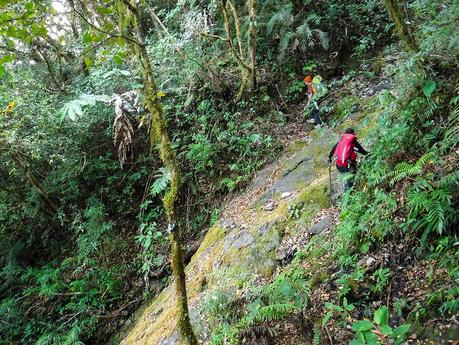
The trove of secrets that a mountain holds deep within its slopes is as lofty as itself. These secrets can unravel a lost story, delight the eye, freshens the tired soul, or forces one to face his or her fears. During our second day of climbing in Mt. Madjaas, we faced some of these secrets.
We woke up early, feeling very refreshed and reinvigorated after a great first day of climbing. A quarter after 6 AM, after eating a hot breakfast and breaking our camp, we proceeded on the second leg of this climb. We crossed the Bantang River river, taking care not to get our feet wet. Walking in wet shoes is one of the most uncomfortable feelings when trekking, and we always try every way to ensure our feet stay dry.
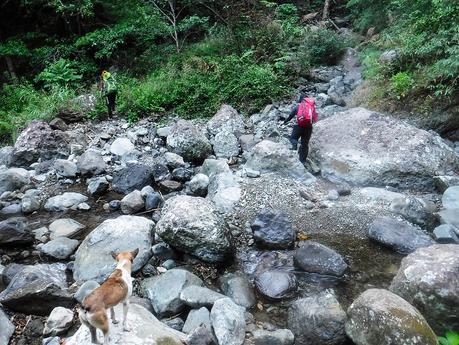
The challenge began right away on the other side of the river. Our first challenge for the day was to climb an almost vertical embankment of loose forest soil. One slip or one wrong move can send us careening back to the rocky riverbank. We don’t want THAT happening.
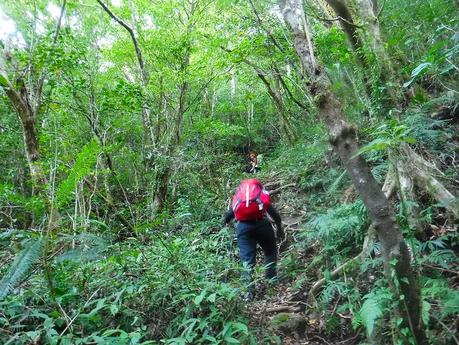
To show you just how steep this embankment is, check out the photo below. That’s no trick, it’s really that steep! Fortunately, there were sturdy roots that make good handholds and footholds. Slowly and carefully, we made our way to the top.
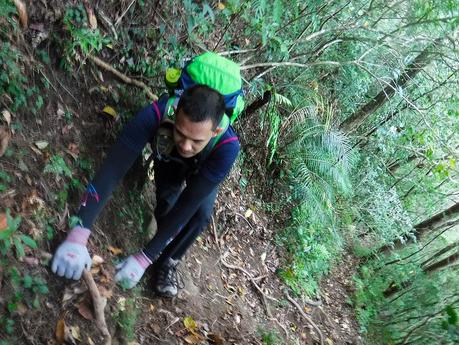
The top of the embankment follows an almost never-ending ascent. The profile of the climb, therefore, suggested that we were taking a direct route to Camp 3 and the summit beyond. While exhausting, it’s actually good news; it’s much shorter than a circuitous journey through the Madjaas range.
Huge, ancient trees like this are everywhere, uncut and untouched. Their thick canopies provided visitors and forest dwellers alike with a respite against the sun’s increasing blaze.
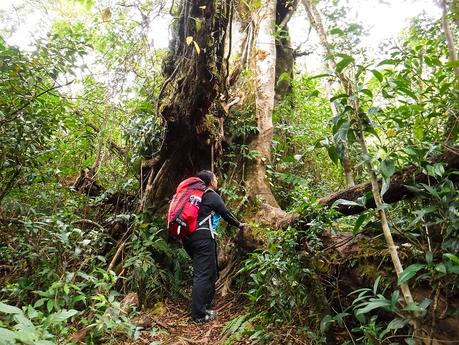
Two hours later, we had a nice respite by walking on rolling terrain. But that respite was just an illusion. The trail goes across very treacherous ravines like the one in the photo below (this is the first of the ravines we need to cross). That ravine goes all the way down the mountain; no one can survive a fall here.
As you can see, certain sections of the trail are just wide enough to accommodate a single shoe! Yes, singular!
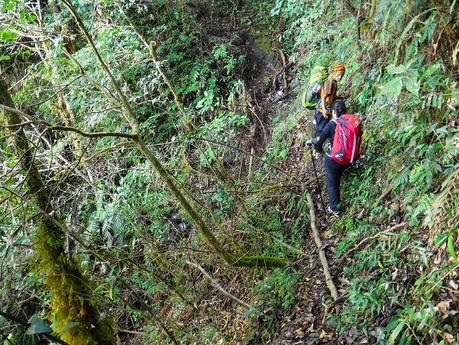
And where the trail disappears, we had to use roots and tiny ledges to traverse the ravine. We didn’t trust our entire weight to one foothold or handhold; the forest is ancient, and many of the features may have rotted or crumbled with age. Slowly and surely, we crossed the first of the dangerous ravines along the way to Mt. Madjaas’ sacred summit.
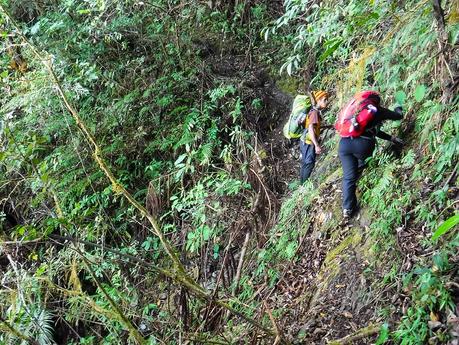
We really had to be careful where we step as we continued down the narrow trail. The forest’s loam soil, rich with moisture, was very soft. Too much weight and the ridge may collapse, taking us along with it. There are trees and foliage to hold on to in case the unthinkable happens. Out here, we are at the mercy of the mountain and the elements she commands.

Further along, we had another heart-stopping moment as we saw another ravine which we need to traverse. This one was even more dangerous than the first because it is actually the rock face of a dried-up waterfall. The moist and mossy surface makes it very slippery, and we had to be doubly extra careful where we put our feet. A simple mistake here, and you know what would happen.
Usually, climbers don’t bring their backpacks here to make the traverse easier and safer; they leave their equipment at the river camp, eschewing the need to spend the night at Camp 3. But we decided otherwise and brought our Deuter ACT Trail packs with us because we plan to take another route on the third day, during our descent.

Another dangerous slippery ravine further down the trail. Just look at how slippery that rock face is.

There were many overhanging roots and branches as well as fallen trees that block the trail. Many times, we had to squeeze our bodies through small gaps to get to the other side of the trail. Yes, due to the tangled mess of trees and vines, climbing Mt. Madjaas also requires you to be somewhat a gymnast. Hahaha!
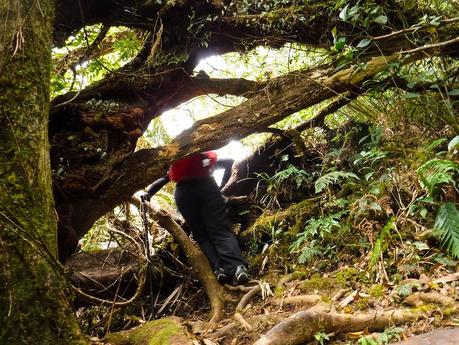
In another section of the trail is a cliff that requires climbers to use a rope to descend safely. Unfortunately, Tatay Josue forgot to bring a climbing rope; the LGU informed him too late that we were coming. As a result, he had to guide us again only after a night’s rest. In his haste, Tatay wasn’t able to secure a rope.
Improvise! We made do with some tough vines so we could go down. This isn’t exactly the safest way to do it, but none of us were heavyset, so it was relatively safe. But we do prefer the safety offered by a proper climbing rope though.
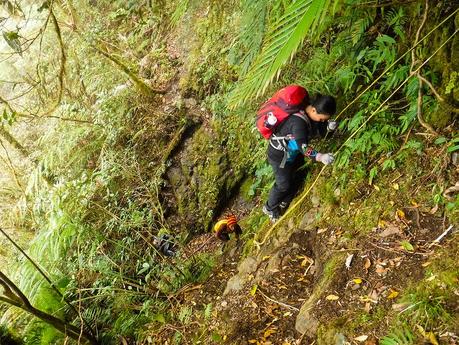
Some sections of the trail may be seemingly straightforward. Look at the photo below; aside from it being quite steep, there’s really nothing special about it, right?
Well, not really. If you look closely at both sides of the trail, you’ll realize that we’re walking along a knife edge with deep ravines on both sides! Ascending on all fours on a steep trail straddled between two deep, foliage-covered ravines—now that’s scary!
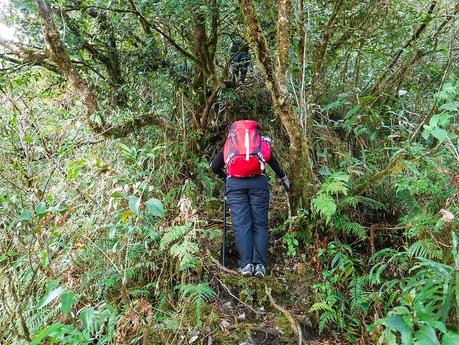
Massive tangles of roots and vines crisscross the trail, hampering our movement. Many of these vines act as bridges that span across deep chasms.
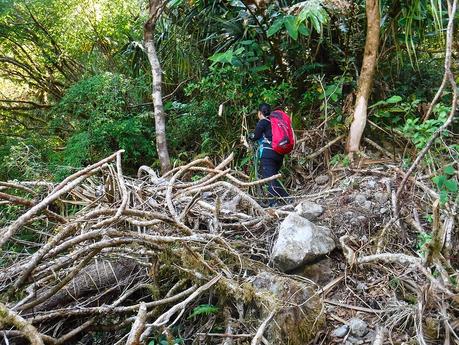
We took a short break near this waterfall. Libog Falls just trickles during summer time, but during rainy season, this waterfall comes alive with a strong torrent.
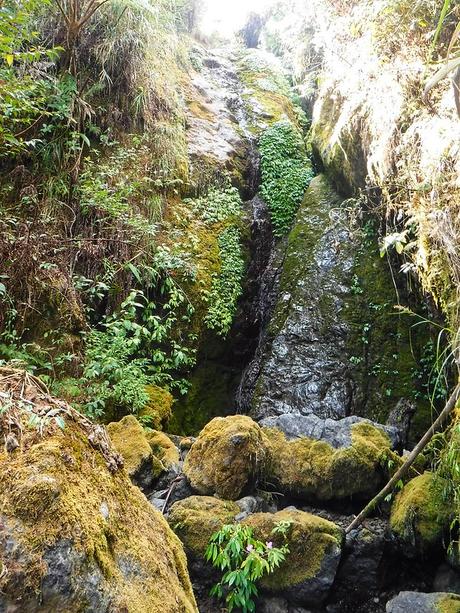
Ancient forests harbor weird plants. These ones look like small purple marbles sprouting from a tree. Hehehe!
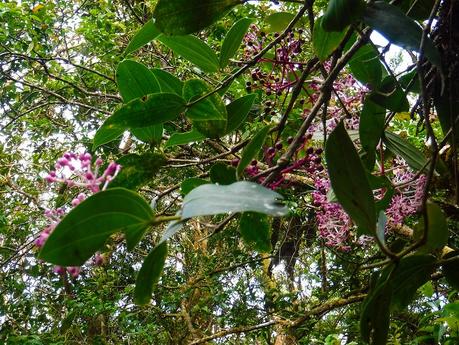
Because a vast majority of Mt. Madjaas is untouched, the trees that comprise the mountain’s forest cover is still first generation. Thick blankets of moss cover the ancient trees that stand guard on this mountain.
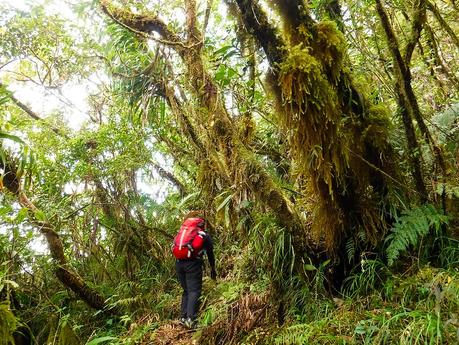
Exposed roots make convenient if not slippery rungs so we can ascend 80 to 90-degree sections of the trail. We still had to be careful though because many of the roots were rotten and easily dislodged.
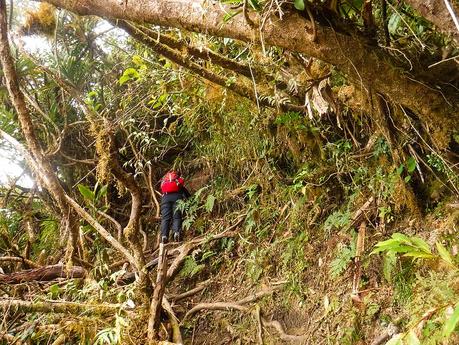
Close to 11 AM, we exited the mossy forest and entered a small hill of sword-sharp cogon grass. The presence of Cogon grass meant that we were near a peak or a top ridge.
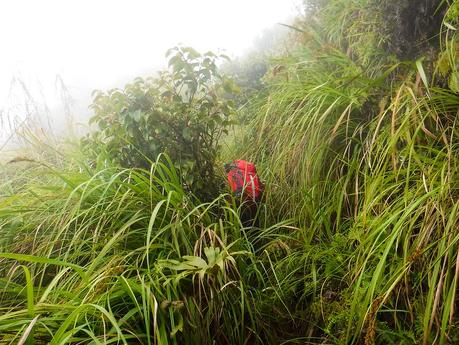
We arrived at the View Deck, a small ledge that juts out of the mountainside. On a clear day, a huge swath of Western Antique can be seen from here. Unfortunately, a thick cloud cover hovered on the upper reaches of Mt. Madjaas, obscuring the view.
Nevertheless, we relaxed a little bit here and talked about our climbing experienced. We had to be careful though because in front of us is a very deep cliff, its edges hidden by thick grass.
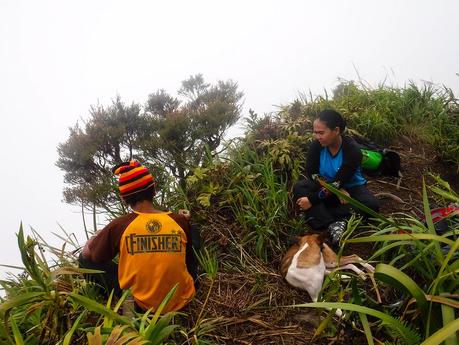
Mini trees? Yes, bonsai plants actually grow here as the high altitude, fertile soil, and moist, cool air provide an ideal environment for such exotic plants to survive.
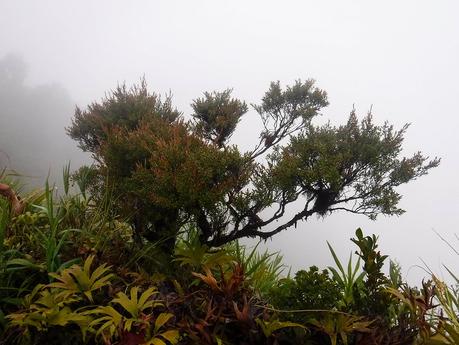
Tatay Josue said Camp 3 is just 30 minutes from the view deck. We can’t wait to get there; the non-stop ascent and heart-stopping traverses over ravines got us quite spent. We went down the narrow trail towards our destination for the day.
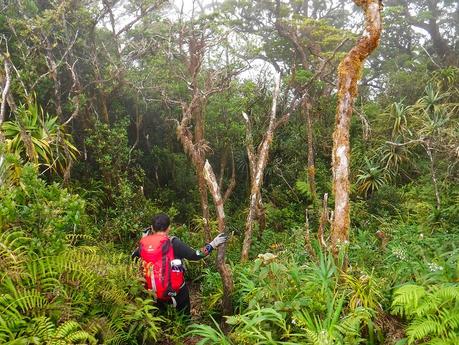
Half an hour later, we arrived at Camp 3, our last campsite for this climb. Camp 3 rests at a large pit at the bottom of the mountain’s shoulder. Surrounding us were walls of trees and cliffs, and the cacophony of various denizens of the forest lulled us to sleep.
After lunch, we took a light nap and waited for the cloud cover to dissipate so we can have some clearing on the summit. Unfortunately, the cloud cover did not let up, so we decided to just make the summit bid very early the next morning. Hopefully, by tomorrow, we’ll have a clear view of the surrounding areas.
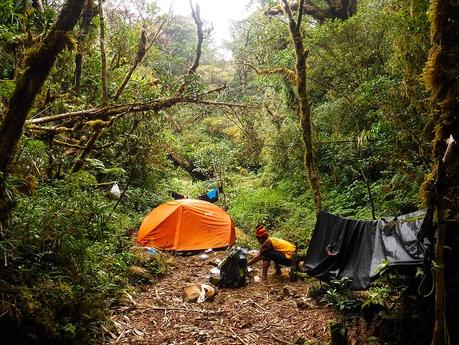
Tatay Josue remarked that it takes almost 3 hours to climb the summit from Camp 3, so we decided to eat dinner and sleep early so we could wake up and start climbing at 3 AM.
While we were cooking our food, Tatay Josue left camp for a while. 15 minutes later, he arrived with a fat, freshly caught freshwater catfish for dinner. Where did he find it? We sliced up the catfish, rubbed it with some salt, and fried it with a bit of oil. The smell roused our appetites even though we just ate lunch a couple of hours ago.
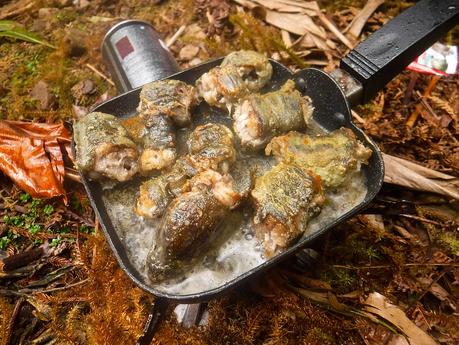
As you can probably see in the photo below, our dinner was really delicious! We had slices of spam, the fried catfish, and some spicy Korean soup. Good thing too that we bought a litro pack of powdered lemonade; in the mountain, anything other than water is just pure bliss!

Kumpol was as tired as we were! Hehehehe! After he had his fill of food, he curled up to sleep, enjoying the cool temperature here.
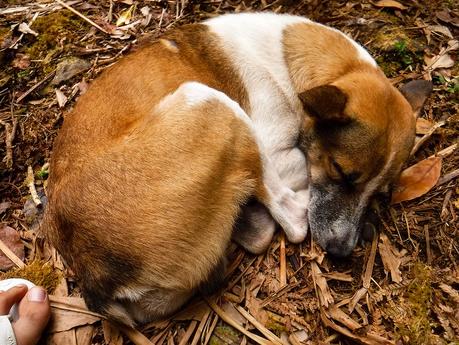
What a great second day although our hearts had the hibby-jibby as we crossed treacherous terrain. Tomorrow, we’re going for the summit! Stay tuned!
For permit, processing, and guide fees, read Part 1 of this series
For important tips in climbing Mt. Madjaas, please stand by for Part 3 of this series.
Budget*
- P 150 per head per day – Permit to Climb fee
- P 600 per guide per group per day – guide fee (guide ratio is 1 guide per 5 climbers)
- P 800 per porter per group per day – porter fee
- P 200 – taxi fare from Kalibo International Airport to Ceres Bus Terminal
- P 234 per person – bus fare from Kalibo to Culasi (same fare applies on the return trip)
- P 350 per motorcycle – one-way habal-habal fare from Culasi to Flores (same fare applies on the return trip)
* Rates are subject to change without further notice. We did not include expenses for food, souvenirs, etc.
Itinerary**
Day 0
Arrival at Culasi, climb registration, free time
Day 1
5:00 AM – wake up call, breakfast
5:30 AM – habal-habal ride to Barangay Flores, meet guide, final preparation
6:30 AM – start trek
12:00 PM – lunch on trail
1:30 PM – arrival at Bantang River campsite, set camp, bathing in the river
4:00 PM – cook dinner
5:00 PM – dinner
6:00 PM – lights off
Day 2
4:30 AM – wake up call, breakfast, prepare lunch, break camp
6:00 AM – resume trek
12:00 PM – arrival at Camp 3, lunch, nap (if the day is clear, you can proceed to the summit)
4:00 PM – cook dinner
5:00 PM – dinner
6:00 PM – lights off
Day 3
2:30 AM – wake up
3:00 AM – assault to summit for sunrise
5:30 AM – arrival at Mt. Madjaas summit
6:00 AM – head back to Camp 3
7:30 AM – arrive at Camp 3, breakfast, prepare packed lunch, break camp
8:30 AM – start descent and traverse via Old Trail
12:00 PM – lunch on trail
7:00 PM – back at Barangay Flores, dinner, spend the night at guide’s house
Day 4
6:00 AM – wake up, breakfast, prepare for departure
7:30 AM – habal-habal ride to Culasi
**Note that this itinerary is according to our pace. Feel free to adjust this itinerary according to your team’s pace.

